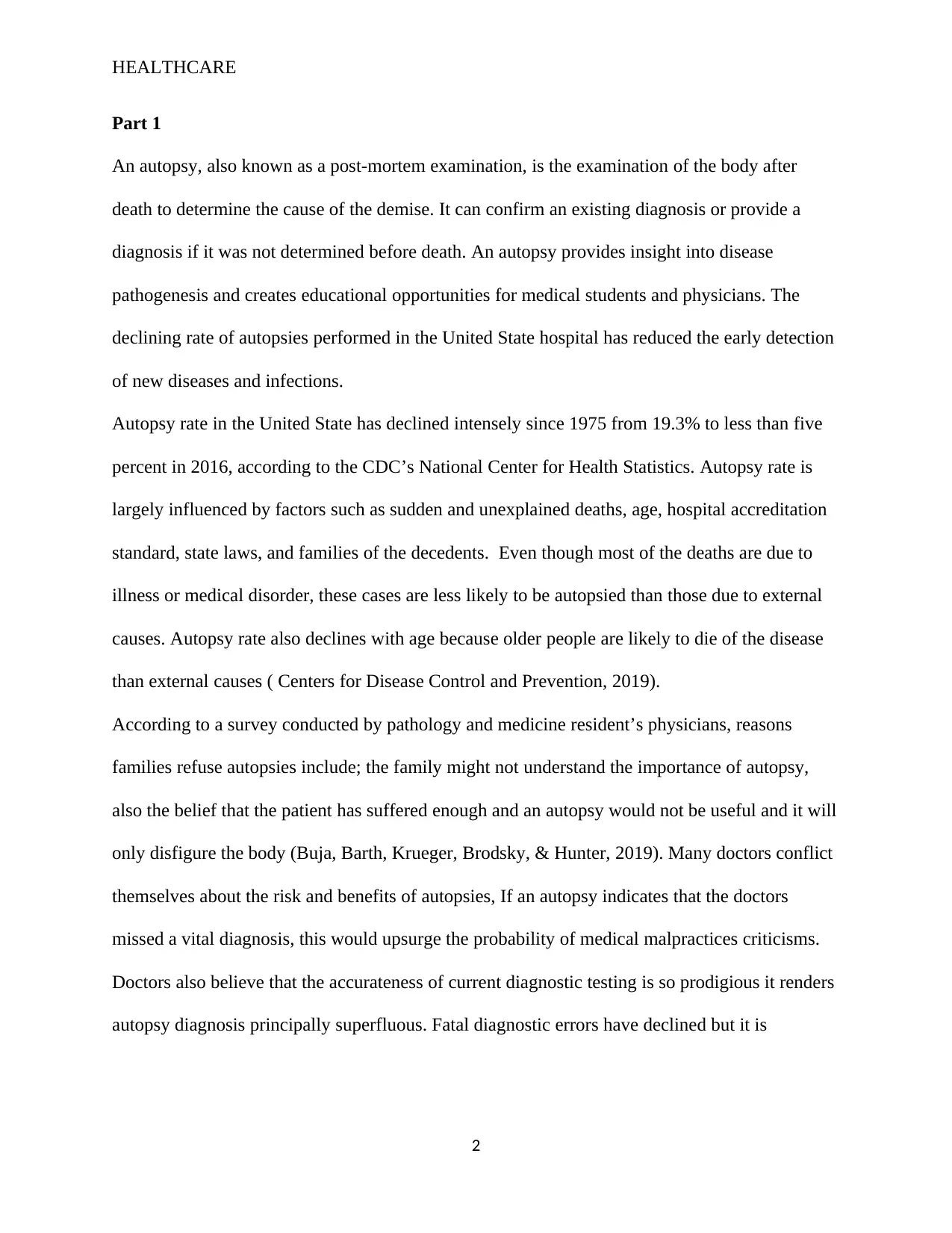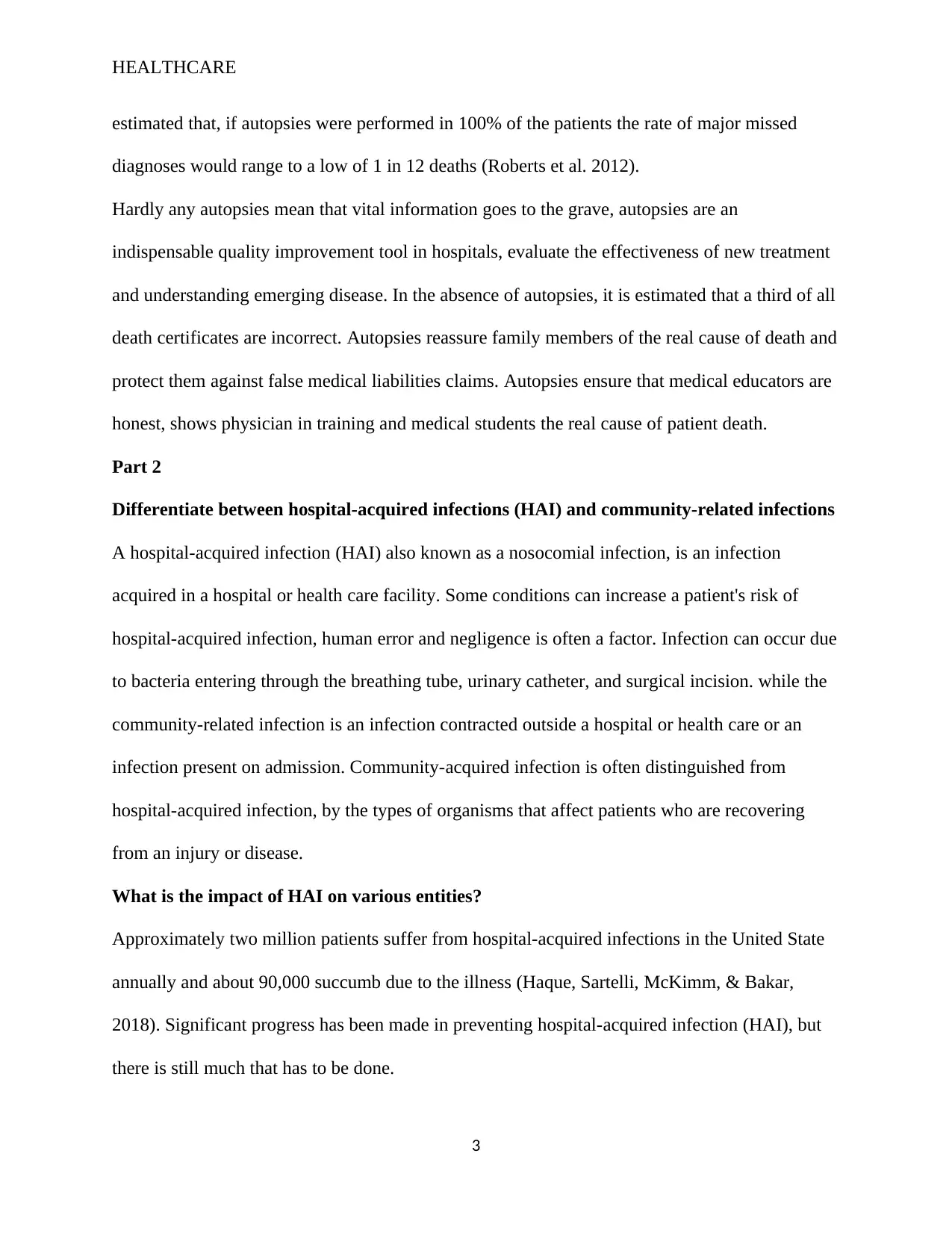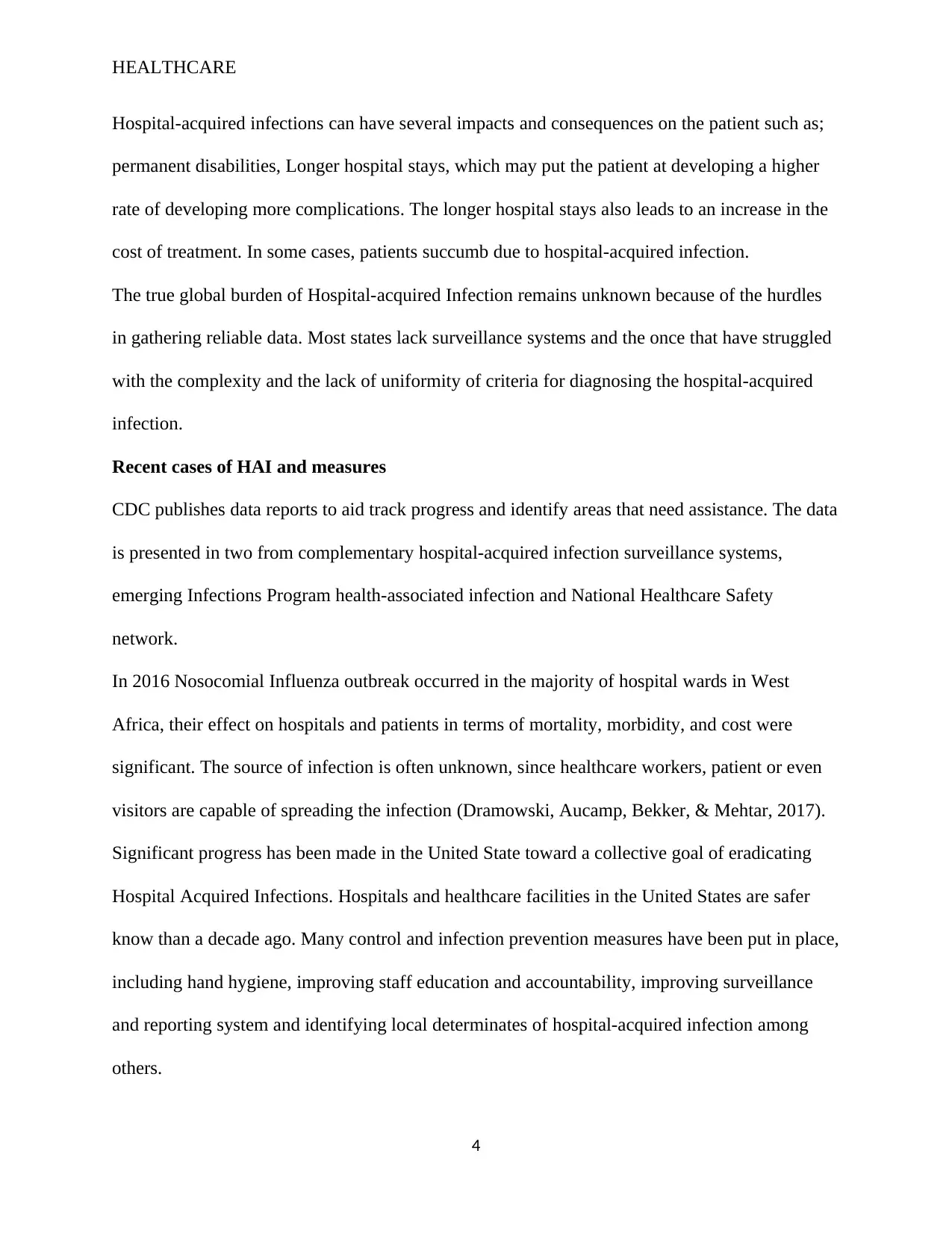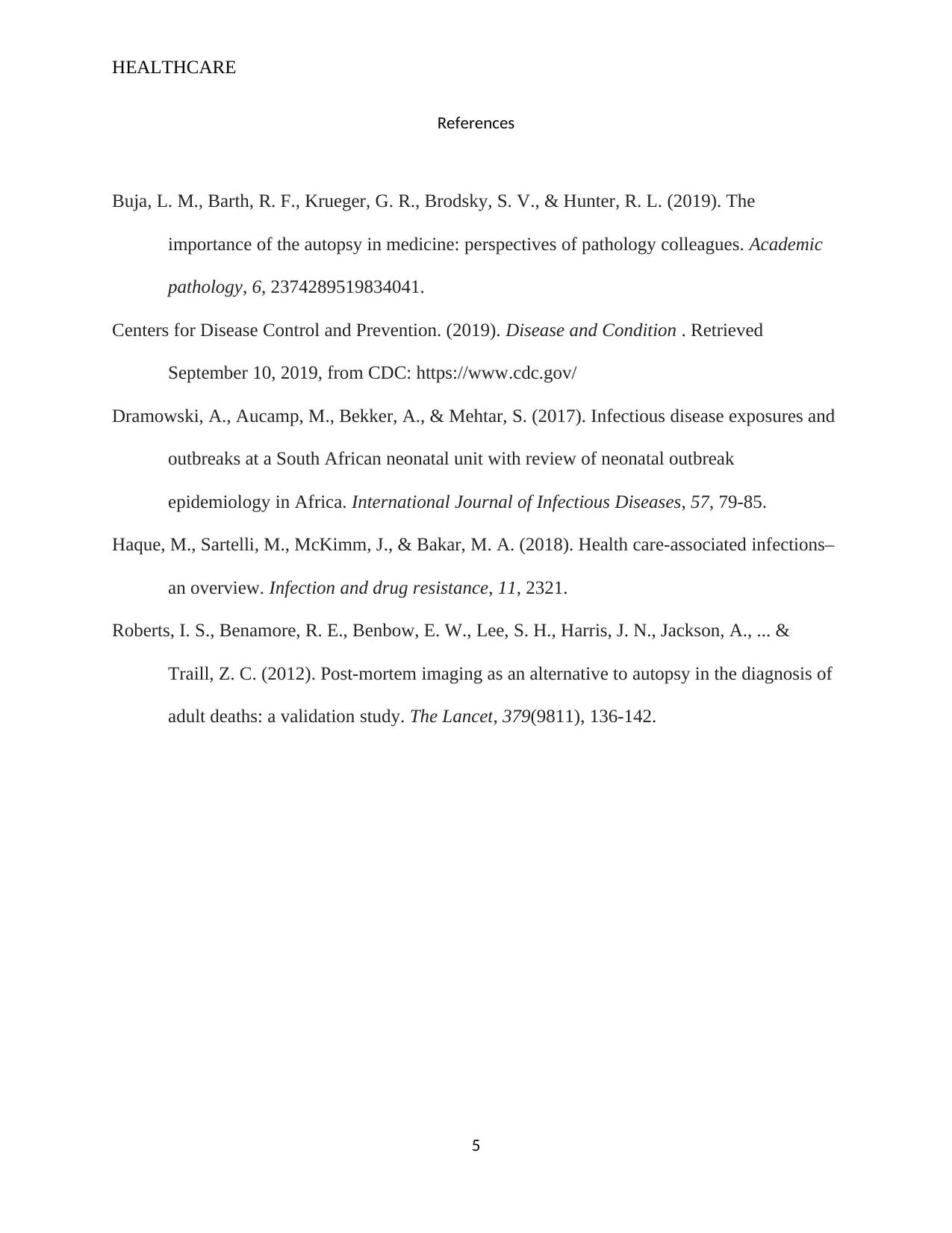Healthcare Report: Autopsies, HAIs, Community Infections, and Impacts
VerifiedAdded on 2022/11/29
|5
|1206
|186
Report
AI Summary
This report delves into two critical aspects of healthcare: autopsies and hospital-acquired infections (HAIs). Part 1 examines autopsies, their declining rates, the factors influencing these rates, and the reasons behind families' refusal to authorize autopsies. It highlights the importance of autopsies in disease detection, medical education, and quality improvement. Part 2 differentiates between hospital-acquired infections (HAIs), also known as nosocomial infections, and community-acquired infections, discussing the impact of HAIs on patients, including permanent disabilities, prolonged hospital stays, and increased treatment costs. The report also explores the global burden of HAIs, surveillance systems, and efforts to prevent and control these infections, referencing recent outbreaks and control measures implemented to improve patient safety. The report includes references to support the information presented.

Running head: HEALTHCARE 1
Name
Course Title
Professor’s Name
Institutional Affiliation
Date
Name
Course Title
Professor’s Name
Institutional Affiliation
Date
Paraphrase This Document
Need a fresh take? Get an instant paraphrase of this document with our AI Paraphraser

HEALTHCARE
Part 1
An autopsy, also known as a post-mortem examination, is the examination of the body after
death to determine the cause of the demise. It can confirm an existing diagnosis or provide a
diagnosis if it was not determined before death. An autopsy provides insight into disease
pathogenesis and creates educational opportunities for medical students and physicians. The
declining rate of autopsies performed in the United State hospital has reduced the early detection
of new diseases and infections.
Autopsy rate in the United State has declined intensely since 1975 from 19.3% to less than five
percent in 2016, according to the CDC’s National Center for Health Statistics. Autopsy rate is
largely influenced by factors such as sudden and unexplained deaths, age, hospital accreditation
standard, state laws, and families of the decedents. Even though most of the deaths are due to
illness or medical disorder, these cases are less likely to be autopsied than those due to external
causes. Autopsy rate also declines with age because older people are likely to die of the disease
than external causes ( Centers for Disease Control and Prevention, 2019).
According to a survey conducted by pathology and medicine resident’s physicians, reasons
families refuse autopsies include; the family might not understand the importance of autopsy,
also the belief that the patient has suffered enough and an autopsy would not be useful and it will
only disfigure the body (Buja, Barth, Krueger, Brodsky, & Hunter, 2019). Many doctors conflict
themselves about the risk and benefits of autopsies, If an autopsy indicates that the doctors
missed a vital diagnosis, this would upsurge the probability of medical malpractices criticisms.
Doctors also believe that the accurateness of current diagnostic testing is so prodigious it renders
autopsy diagnosis principally superfluous. Fatal diagnostic errors have declined but it is
2
Part 1
An autopsy, also known as a post-mortem examination, is the examination of the body after
death to determine the cause of the demise. It can confirm an existing diagnosis or provide a
diagnosis if it was not determined before death. An autopsy provides insight into disease
pathogenesis and creates educational opportunities for medical students and physicians. The
declining rate of autopsies performed in the United State hospital has reduced the early detection
of new diseases and infections.
Autopsy rate in the United State has declined intensely since 1975 from 19.3% to less than five
percent in 2016, according to the CDC’s National Center for Health Statistics. Autopsy rate is
largely influenced by factors such as sudden and unexplained deaths, age, hospital accreditation
standard, state laws, and families of the decedents. Even though most of the deaths are due to
illness or medical disorder, these cases are less likely to be autopsied than those due to external
causes. Autopsy rate also declines with age because older people are likely to die of the disease
than external causes ( Centers for Disease Control and Prevention, 2019).
According to a survey conducted by pathology and medicine resident’s physicians, reasons
families refuse autopsies include; the family might not understand the importance of autopsy,
also the belief that the patient has suffered enough and an autopsy would not be useful and it will
only disfigure the body (Buja, Barth, Krueger, Brodsky, & Hunter, 2019). Many doctors conflict
themselves about the risk and benefits of autopsies, If an autopsy indicates that the doctors
missed a vital diagnosis, this would upsurge the probability of medical malpractices criticisms.
Doctors also believe that the accurateness of current diagnostic testing is so prodigious it renders
autopsy diagnosis principally superfluous. Fatal diagnostic errors have declined but it is
2

HEALTHCARE
estimated that, if autopsies were performed in 100% of the patients the rate of major missed
diagnoses would range to a low of 1 in 12 deaths (Roberts et al. 2012).
Hardly any autopsies mean that vital information goes to the grave, autopsies are an
indispensable quality improvement tool in hospitals, evaluate the effectiveness of new treatment
and understanding emerging disease. In the absence of autopsies, it is estimated that a third of all
death certificates are incorrect. Autopsies reassure family members of the real cause of death and
protect them against false medical liabilities claims. Autopsies ensure that medical educators are
honest, shows physician in training and medical students the real cause of patient death.
Part 2
Differentiate between hospital-acquired infections (HAI) and community-related infections
A hospital-acquired infection (HAI) also known as a nosocomial infection, is an infection
acquired in a hospital or health care facility. Some conditions can increase a patient's risk of
hospital-acquired infection, human error and negligence is often a factor. Infection can occur due
to bacteria entering through the breathing tube, urinary catheter, and surgical incision. while the
community-related infection is an infection contracted outside a hospital or health care or an
infection present on admission. Community-acquired infection is often distinguished from
hospital-acquired infection, by the types of organisms that affect patients who are recovering
from an injury or disease.
What is the impact of HAI on various entities?
Approximately two million patients suffer from hospital-acquired infections in the United State
annually and about 90,000 succumb due to the illness (Haque, Sartelli, McKimm, & Bakar,
2018). Significant progress has been made in preventing hospital-acquired infection (HAI), but
there is still much that has to be done.
3
estimated that, if autopsies were performed in 100% of the patients the rate of major missed
diagnoses would range to a low of 1 in 12 deaths (Roberts et al. 2012).
Hardly any autopsies mean that vital information goes to the grave, autopsies are an
indispensable quality improvement tool in hospitals, evaluate the effectiveness of new treatment
and understanding emerging disease. In the absence of autopsies, it is estimated that a third of all
death certificates are incorrect. Autopsies reassure family members of the real cause of death and
protect them against false medical liabilities claims. Autopsies ensure that medical educators are
honest, shows physician in training and medical students the real cause of patient death.
Part 2
Differentiate between hospital-acquired infections (HAI) and community-related infections
A hospital-acquired infection (HAI) also known as a nosocomial infection, is an infection
acquired in a hospital or health care facility. Some conditions can increase a patient's risk of
hospital-acquired infection, human error and negligence is often a factor. Infection can occur due
to bacteria entering through the breathing tube, urinary catheter, and surgical incision. while the
community-related infection is an infection contracted outside a hospital or health care or an
infection present on admission. Community-acquired infection is often distinguished from
hospital-acquired infection, by the types of organisms that affect patients who are recovering
from an injury or disease.
What is the impact of HAI on various entities?
Approximately two million patients suffer from hospital-acquired infections in the United State
annually and about 90,000 succumb due to the illness (Haque, Sartelli, McKimm, & Bakar,
2018). Significant progress has been made in preventing hospital-acquired infection (HAI), but
there is still much that has to be done.
3
⊘ This is a preview!⊘
Do you want full access?
Subscribe today to unlock all pages.

Trusted by 1+ million students worldwide

HEALTHCARE
Hospital-acquired infections can have several impacts and consequences on the patient such as;
permanent disabilities, Longer hospital stays, which may put the patient at developing a higher
rate of developing more complications. The longer hospital stays also leads to an increase in the
cost of treatment. In some cases, patients succumb due to hospital-acquired infection.
The true global burden of Hospital-acquired Infection remains unknown because of the hurdles
in gathering reliable data. Most states lack surveillance systems and the once that have struggled
with the complexity and the lack of uniformity of criteria for diagnosing the hospital-acquired
infection.
Recent cases of HAI and measures
CDC publishes data reports to aid track progress and identify areas that need assistance. The data
is presented in two from complementary hospital-acquired infection surveillance systems,
emerging Infections Program health-associated infection and National Healthcare Safety
network.
In 2016 Nosocomial Influenza outbreak occurred in the majority of hospital wards in West
Africa, their effect on hospitals and patients in terms of mortality, morbidity, and cost were
significant. The source of infection is often unknown, since healthcare workers, patient or even
visitors are capable of spreading the infection (Dramowski, Aucamp, Bekker, & Mehtar, 2017).
Significant progress has been made in the United State toward a collective goal of eradicating
Hospital Acquired Infections. Hospitals and healthcare facilities in the United States are safer
know than a decade ago. Many control and infection prevention measures have been put in place,
including hand hygiene, improving staff education and accountability, improving surveillance
and reporting system and identifying local determinates of hospital-acquired infection among
others.
4
Hospital-acquired infections can have several impacts and consequences on the patient such as;
permanent disabilities, Longer hospital stays, which may put the patient at developing a higher
rate of developing more complications. The longer hospital stays also leads to an increase in the
cost of treatment. In some cases, patients succumb due to hospital-acquired infection.
The true global burden of Hospital-acquired Infection remains unknown because of the hurdles
in gathering reliable data. Most states lack surveillance systems and the once that have struggled
with the complexity and the lack of uniformity of criteria for diagnosing the hospital-acquired
infection.
Recent cases of HAI and measures
CDC publishes data reports to aid track progress and identify areas that need assistance. The data
is presented in two from complementary hospital-acquired infection surveillance systems,
emerging Infections Program health-associated infection and National Healthcare Safety
network.
In 2016 Nosocomial Influenza outbreak occurred in the majority of hospital wards in West
Africa, their effect on hospitals and patients in terms of mortality, morbidity, and cost were
significant. The source of infection is often unknown, since healthcare workers, patient or even
visitors are capable of spreading the infection (Dramowski, Aucamp, Bekker, & Mehtar, 2017).
Significant progress has been made in the United State toward a collective goal of eradicating
Hospital Acquired Infections. Hospitals and healthcare facilities in the United States are safer
know than a decade ago. Many control and infection prevention measures have been put in place,
including hand hygiene, improving staff education and accountability, improving surveillance
and reporting system and identifying local determinates of hospital-acquired infection among
others.
4
Paraphrase This Document
Need a fresh take? Get an instant paraphrase of this document with our AI Paraphraser

HEALTHCARE
References
Buja, L. M., Barth, R. F., Krueger, G. R., Brodsky, S. V., & Hunter, R. L. (2019). The
importance of the autopsy in medicine: perspectives of pathology colleagues. Academic
pathology, 6, 2374289519834041.
Centers for Disease Control and Prevention. (2019). Disease and Condition . Retrieved
September 10, 2019, from CDC: https://www.cdc.gov/
Dramowski, A., Aucamp, M., Bekker, A., & Mehtar, S. (2017). Infectious disease exposures and
outbreaks at a South African neonatal unit with review of neonatal outbreak
epidemiology in Africa. International Journal of Infectious Diseases, 57, 79-85.
Haque, M., Sartelli, M., McKimm, J., & Bakar, M. A. (2018). Health care-associated infections–
an overview. Infection and drug resistance, 11, 2321.
Roberts, I. S., Benamore, R. E., Benbow, E. W., Lee, S. H., Harris, J. N., Jackson, A., ... &
Traill, Z. C. (2012). Post-mortem imaging as an alternative to autopsy in the diagnosis of
adult deaths: a validation study. The Lancet, 379(9811), 136-142.
5
References
Buja, L. M., Barth, R. F., Krueger, G. R., Brodsky, S. V., & Hunter, R. L. (2019). The
importance of the autopsy in medicine: perspectives of pathology colleagues. Academic
pathology, 6, 2374289519834041.
Centers for Disease Control and Prevention. (2019). Disease and Condition . Retrieved
September 10, 2019, from CDC: https://www.cdc.gov/
Dramowski, A., Aucamp, M., Bekker, A., & Mehtar, S. (2017). Infectious disease exposures and
outbreaks at a South African neonatal unit with review of neonatal outbreak
epidemiology in Africa. International Journal of Infectious Diseases, 57, 79-85.
Haque, M., Sartelli, M., McKimm, J., & Bakar, M. A. (2018). Health care-associated infections–
an overview. Infection and drug resistance, 11, 2321.
Roberts, I. S., Benamore, R. E., Benbow, E. W., Lee, S. H., Harris, J. N., Jackson, A., ... &
Traill, Z. C. (2012). Post-mortem imaging as an alternative to autopsy in the diagnosis of
adult deaths: a validation study. The Lancet, 379(9811), 136-142.
5
1 out of 5
Related Documents
Your All-in-One AI-Powered Toolkit for Academic Success.
+13062052269
info@desklib.com
Available 24*7 on WhatsApp / Email
![[object Object]](/_next/static/media/star-bottom.7253800d.svg)
Unlock your academic potential
Copyright © 2020–2025 A2Z Services. All Rights Reserved. Developed and managed by ZUCOL.





